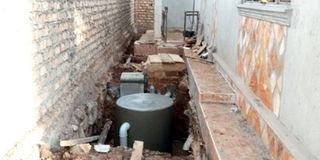Biodigester: Sewage solution for homes with limited space

The biodigester can be constructed on small space and does not release a stench. Courtesy photo
What you need to know:
- According to Derrick Lubwama, a construction engineer who has built many bio digesters, the bio-digester is cheaper than the more known septic tank.
- A one cubic metre tank that can serve one to 21 people daily and can be installed within four working days at Shs3m - material and labour costs inclusive. One tank of two cubic metres that can serve one to 50 people can be installed at Shs4m or more.
Many people have for long suffered the stench that comes with poor disposal of sewage. Many go for septic tanks, which cost a lot of money and space yet most homes are built in small spaces.
According to Ethel Namono, a professional landscaper with Iconic hedges, a biodigester system which was invented with the aim of improving hygiene in homes, solves the stench problem.
“The system is very economical and a sustainable substitute for a septic tank that people say costs a lot of money to construct. The biodigester tanks appear small but hardly fill up and can be installed in any corner of the home. People with small plots do not have to worry about space,” Namono says.
Namono adds that with a biodigester, you do not need to spend a fortune on building a septic tank or soak pit.
Biodigester is an on-site system, which consumes a small space of 1.1meter diameter by 1.1-mere depth. It takes two meters by 1meter depth.
How the system works Through a process of controlled anaerobic digestion of human waste, the biodigester produces usable sub products such as biogas, organic compost and water for domestic use.
This system consists of an inlet that collects sewage from different points into an outlet that transports it to the soak pit.
A bio digester consists of three main parts and these aid the whole process. First, is a grease interceptor, a biological digester and a soak pit. These parts also separate waste into grey and black waters.
Why consider a biodigester
The many advantages that come with the system are the very reasons one would invest in this system. According to Namono, the system is environmentally friendly because it prevents a bad stench. It, therefore, improves sanitation.
The production of renewable energy that is biogas and can be used in cooking is added advantage. The cost of other gas from companies is very high and there is scarcity of firewood, which has also led to charcoal being expensive. This will be the perfect solution for a home.
It also helps in fertilisation of the soil and reduction of free methane emissions. Remember the emissions will now be in form of bio-gas. The solid sludge will be used as fertilisers.
Away from that, this technology leads to a drastic reduction of human waste dislodging and minimises on the risks of contamination.
The biodigester system recycles nutrients to generate usable sub products such as soil nutrients for healthy plants.
Namono says the biodigester tank works well for families, schools, and hospitals because it eliminates the risk of spreading diseases. Namono says those with ordinary septic tanks should not lose hope, they can convert them into modern biological tanks by fitting a bio digester and breaking down the sewage matter will certainly take a few days.
Maintenance
Maintenance of the biodigesters is easy and sustainable. Namono says if three necessary activities to keep the system efficiently working are respected, one will never find any problem with it.
Users should avoid any plastic or other solid material from being thrown into the toilets. These may block the connection to the bio digester hence leading to stench and back flow of sewage causing a very unfriendly environment.
These plastics may also affect the production of gas and make the dislodging operation difficult. However toilet paper can be thrown in the toilet.
Solid waste should be dislodged once every two to three years. Excessive leaking of water is a sign that the solid waste is full and the operation is needed. For a bio digester built for schools, with an average use of 50 students per toilet per day, it is necessary to dislodge the solid part twice every two to three years.
Cost
According to Derrick Lubwama, a construction engineer who has built many bio digesters, the bio-digester is cheaper than the more known septic tank.
A one cubic metre tank that can serve one to 21 people daily and can be installed within four working days at Shs3m - material and labour costs inclusive. One tank of two cubic metres that can serve one to 50 people can be installed at Shs4m or more.
A bio diversity system of three cubic metres that can serve 200 people and more can be installed within nine working days at Sh4.5m with additional income raising with unavoidable circumstances.
One of four cubic metres that serves between 600 to 1,000 people can be installed at Shs5m or more.
Lubwama adds that the system is relatively cheap if you compare the many advantages it has.




